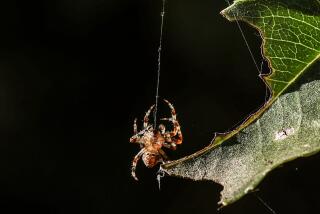Of spiders and stitches and more
Vampire bats aren’t the only ghoulish creatures carrying around potential health treats. Now researchers are eyeing spider webs for a tricky new biomaterial that could be used in various medical applications.
How it’s made:
A typical spider spins six different kinds of silk, says Randy Lewis, professor of molecular biology at the University of Wyoming. Some silks get woven into specific patterns for a web; other kinds become a death shroud for trapped insects. All are bouncy and super-tough. “Typical spider silk is actually five times stronger than steel,” Lewis says.
He and his team have genetically engineered bacteria with synthetic spider silk genes. The bacteria can make spider silk proteins on demand, with varying degrees of strength and elasticity. Lewis collects the protein fibers and then spins his own spider silk in the lab. One Canadian company, Nexia Biotechnologies Inc.’s BioSteel, has also tested other large-scale production mechanisms — in the mammary glands of goats.
Where it might go:
With mass production, spider silk would make excellent surgical suture material, Lewis says. The threads could be as strong as current materials, but up to 10 times thinner. Tiny stitches would be a boon for fields such as eye surgery, neurosurgery or plastic surgery. And unlike silkworm silk and other materials, spider silk doesn’t trigger an immune response in the body.
Toughness and flexibility also make spider silk a natural possibility for artificial ligaments. No good alternatives for ligaments or tendons are available, Lewis says.
In the far future, he envisions even more nifty orthopedic scenarios. Spider silk could function as a temporary replacement ligament in the knee while serving as a scaffold on which stem cells would grow — and as the cells matured, the natural ligament could slowly take over from the spider silk ligament until the regenerated knee ligament was fully grown.
The same bouncy qualities that allow spider webs to catch high-flying insects without snapping might also make the silk useful in other situations: in automobile air bags. Air bags blow passengers back into the seat with explosive force, Lewis says, but silk air bags might be able to absorb more energy. This could reduce air bag injuries and even make them safe for use with infants in car seats.
Why it’s taking so long:
“It’s very difficult to get spider silk,” Lewis says. His team had to resort to surgery during recent studies — anesthetizing the spiders and extracting their silk fibers, one spider at a time. In England and France in the 19th century, ambitious researchers tried other methods, he says. They copied the industry’s techniques for silkworm cultivation and attempted to breed lots of spiders in close quarters. “But spiders aren’t like silkworms,” Lewis says. “Spiders aren’t sociable. They just tended to kill each other.”






